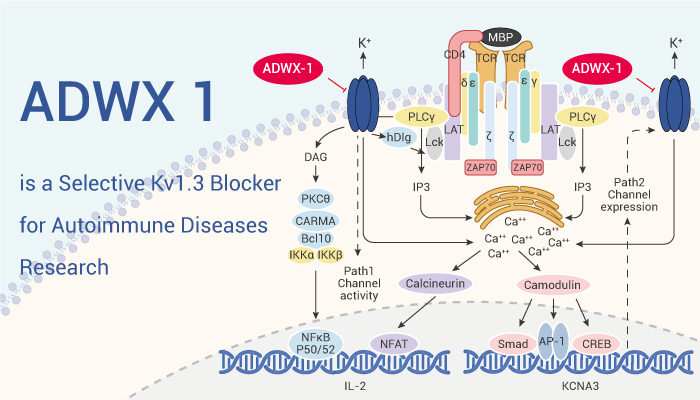Kv1.3 is a classic shaker-type potassium channel with six transmembrane segments that was discovered in the early 1980s in a non-excitable cell, T lymphocytes. Kv1.3 is the first K+; channel identified outside of electrically excitable tissues. In T lymphocytes it is responsible for controlling membrane potential, which is critical for the activation of these immune cells.
ADWX 1 is a new peptide inhibitor that is potent and selective for Kv1.3 with an IC50 value of 1.89 pM. Moreover, ADWX 1 inhibits Kv1.3 channel activity specifically to inhibit both the initial calcium signaling and NF-κB activation. In addition, it ameliorates the disease in rats of experimental autoimmune encephalomyelitis (EAE) models. ADWX 1 can play a role in the study of T cell-mediated autoimmune diseases.

ADWX 1 is a selective Kv1.3 blocker for autoimmune disease research.
In vitro studies, ADWX 1 (1,10 nM, 1 h) inhibits IL-2 and IFN-γ productions and inhibits human CD4+CCR7–; TEM cells activation selectively. ADWX 1 (1,10 nM, 50 min) reduces [Ca2+;] in activated CD4+CCR7– TCM cells from EAE rats. Besides, it (1,10 nM, 1 h) reduces NF-κB activation and suppresses Kv1.3 expression at both mRNA and protein levels preferentially in myelin basic protein (MBP) (HY-P77995)-stimulated T cells from EAE rats. Also, ADWX 1 (1,10 nM, 3 days) suppresses Th17 activation but not differentiation in T cells.
In vivo studies, ADWX 1 (100 μg/kg/day, s.c., 3 days) ameliorates the disease through the inhibition of IL-2 and IFN-γ productions and CCR7- TEM proliferation in EAE of Sprague-Dawley rats. It (5/10 mg/kg, s.c., 2 weeks) induces no pathological changes in the behavior or tissues of the rats (acute toxicity assay). It reduced neurological scores compared with vehicle-treated rats on days 10, 11, 12, 13 and 14. Inhibited IL-2 and IFN-γ productions. Inhibited the T cell proliferation triggered by high and low concentrations of myelin antigen in a dose-dependent manner.
In summary, ADWX 1 is a novel peptide that potently targets and inhibits Kv1.3, specifically inhibits Kv1.3 channel activity.
References:
[1] Song Han, et al. J Biol Chem. 2008 Jul 4;283(27):19058-65.
[2] Zhi Li, et al. J Biol Chem. 2012 Aug 24;287(35):29479-94.